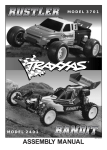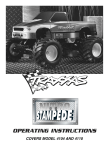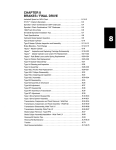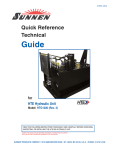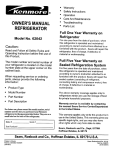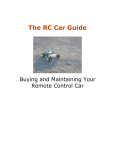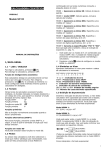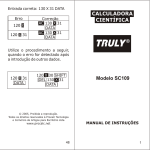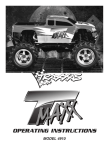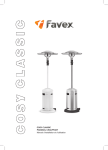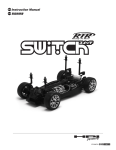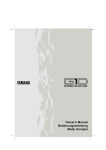Download Traxxas 4801 Motorized Toy Car User Manual
Transcript
ASSEMBLY MANUAL, TUNING GUIDE MODEL 4801 INTRODUCTION Thank you for purchasing a Traxxas Nitro 4-Tec Pro. This limited-edition, pro kit is loaded with all the latest sedan racing hardware and engineering technology. This pro kit does not come with an engine or tuned pipe, allowing you to choose an engine which is legal for your race track. If racing regulations do not limit you to a .12 size engine, then install the TRX Pro .15 engine for fast, asphalt-blistering excitement. The Nitro 4-Tec Pro features dual adjustable pro ball differentials smoothly distribute the power to each corner of the car. Handling is quick and precise with fully-independent suspension and tuneable, oil-filled, pro-level, aluminum Big-Bore shocks. Nitro 4-Tec Pro kit includes a two-speed, auto-shifting transmission; full ball bearings; Lunsford™ titanium hinge pins and turnbuckles; Perfect-Fit™ blue-anodized, aluminum header; Pro-Line™ V-Rage™ tires; 2.0” aluminum finish, mesh wheels; and graphite chassis components. This manual covers the assembly and tuning process for the Nitro 4-Tec Pro kit. Look over this entire manual and examine the Nitro 4-Tec Pro carefully before assembling it. If for some reason you think the Nitro 4Tec Pro is not what you wanted, then do not continue any further. Your hobby dealer absolutely cannot accept a Nitro 4-Tec Pro kit for return or exchange after any of the kit bags have been opened. If you have any questions about your new Nitro 4-Tec Pro, call Traxxas’ technical support department at (888)TRAXXAS (U.S.A. residents only). Outside U.S.A. call 972-265-8000. Technical support is available Monday through Friday, from 8:30 AM to 5:30 PM Central Time. You may also email us at our website, www.Traxxas.com. We hope that you will enjoy your Nitro 4-Tec Pro race car. ASSEMBLY HINTS To assemble this kit, you’ll need a large flat working area where you will have plenty of room to build. Be sure it is some place where you can leave your work spread out and not in the way when you want to take a break from the assembly. Allow yourself plenty of time to build this kit. The assembly time is going to vary with each individual. Experienced builders may only need 4 - 5 hours to assemble this kit, while others may spend an entire weekend on it. You should feel comfortable with taking as much time as you need to properly build and set-up your model. The race, after all, is on the track, not the workbench. If you have already been exploring the contents of your kit box, you’ve noticed that there are many bags of small parts. A parts box has been provided with your kit to keep all of these small parts organized and easily accessible. As you open a bag of hardware, use what you need and pour the remainder in one of the compartments. The compartments are labled in procession with the assembly step numbers. Some extra hardware may be left over when the car is assembled. 2 While it is possible to assemble your model just by following the pictures, please read the text next to each photo. The text contains important information you need such as screw sizes or assembly tips. ADDITIONAL COMPONENTS You will need these important components to complete this kit: •Engine •Two-channel radio system •Tuned pipe •Engine Fuel & dispenser •Body (200mm) NOTE: The Nitro 4-Tec Pro is designed to use a .12.15, side-exhaust, short crankshaft engine with backplate (requires starter box) or pull starter. Some wider pull starters, such as O.S. and clones, will not fit. TOOLS YOU WILL NEED Some of the tools which you will need to assemble this kit have been provided for you, they include: 1.5mm hex wrench 2.0mm hex wrench 4-way wrench U-joint assembly tool 2.5mm Hex wrench Turnbuckle wrench To complete your kit, you will need some basic hand tools such as: small hammer #1 Philips screwdriver #2 Philips screwdriver Flat blade screwdriver (.25 inches wide) Channellock™ pliers Needlenose pliers Hobby knife Small, flat-blade, jeweler’s screwdriver Thread-locking compound, such as Locktite™ The tools and accessories pictured are also necessary for correct assembly. 60-WT Silicone Shock Oil 3mm Tap Metric Hex Drivers CA Glue Snap Ring Pliers WARRANTY STATEMENT Every effort has been made in component design and material selection to make your model as durable as possible and still maintain a competitive race weight. Because this model is intended for use in high speed competition under the most severe conditions, no warranties are expressed or implied relating to the longevity of the parts. If you find a part that has a defect in materials or workmanship, please return it to us BEFORE IT IS USED, and we will gladly replace it. Damage caused by crash damage, excessive force, abuse, neglect, or failure to adhere to the precautions outlined in the literature contained with your model will void the warranty. HARDWARE DESCRIPTION The drawings that follow are provided to help you identify the many different sizes and types of hardware you will be using as you assemble this kit. Note the difference between the length measurements of the roundhead and countersunk screws. A ruler is provided at the bottom of each page to measure the length of the screws in millimeters. 4mm Countersunk Cap Screw Buttonhead Cap Screw Shoulder Screw Countersunk Self-tapping Screw Washerhead Self-tapping Screw Roundhead Self-tapping Screw Nylon Locknut Flange Nut Grub Screw Plastic Bushing Aluminum Spacer Plastic Washer 6mm 3mm Metal Washer 3x6x4mm Spacer PTFE Washer Split Washer 3mm E-Clip 12mm 3x12mm Countersunk machine screw 3mm 12mm 3x12mm Roundhead machine screw Oilite Bushing CENTERING THE SERVOS The kit version does not include the radio system. The photos in this manual do show the installation of a typical radio system. Before installing the radio system, find the center neutral position of the steering and throttle servos. Connect the radio system according to your manufacturer’s instructions. Install fresh batteries. Turn on the transmitter and receiver. Set the throttle and steering trims to their neutral positions. Now turn off the receiver, followed by the transmitter. Be careful not to turn any of the servo output shafts during installation. 3 Please follow the precautions at all times. Operate your Nitro 4-Tec Pro sensibly and with care and it will be exciting, safe, and fun for you and your spectators. Failure to operate your Nitro 4-Tec Pro in a safe and responsible manner could result in property damage and serious injury. You alone must see to it that the instructions are followed and the precautions are adhered to. The Nitro 4-Tec Pro is not intended for use by children without the supervision of a responsible adult. Every precaution outlined in this manual should be followed to help ensure safe operation. Traxxas Corporation shall not be liable for any loss or damages, whether direct, indirect, special, incidental, or consequential, arising from the use, misuse, or abuse of this product and any chemical or accessory required to operate this product. • The fuel is dangerous and poisonous. Follow all of the direction and precautions on the fuel container. • The fuel can look like a cool drink to a young child. Keep it out of children’s reach. • The fuel is flammable. Do not allow sparks, flame, or smoking in the presence of model fuel. • The engine emits poisonous carbon monoxide gas just like a real automobile engine. Always run the model in a well-ventilated area. Never attempt to run the engine indoors unless there is adequate ventilation. • The engine and exhaust system become extremely hot during use. Be careful not to touch these parts, espe cially when refueling. • Do not drive the Nitro 4-Tec Pro at night. • Never, under any circumstances, operate the Nitro 4-Tec Pro in crowds of people. The model is very fast and could cause injury if allowed to collide with anyone. • Because the Nitro 4-Tec Pro is controlled by radio, it is subject to radio interference from many sources that are beyond your control. Since radio interference can cause momentary losses of radio control, always allow a safety margin in all directions around the car in order to prevent collisions. • The engine can be very loud.If the noise makes you uncomfortable, wear ear protection. Be considerate of your neighbors by not running your model early in the morning or late in the evening. • Most importantly, use good, common sense at all times. GEAR RATIOS Another Nitro 4-Tec Pro feature is the ability to change the gear ratios. Currently, there are three optional gear ratios for the Nitro 4-Tec Pro. The stock gear ratio will provide the best acceleration. A higher (lower numerical) gear ratio provides extreme top speed primarily intended for flat-out running on large, unobstructed, paved areas. Organized, 1/10 scale, nitro touring car racing is typically done on smaller, closed courses. For this type of racing use a lower (higher numerical) gear ratio such as the stock gear ratio. The following chart gives the four possible gear ratios sets. The ratios are arranged from highest (lowest numerical) to lowest (highest numerical). A brief application recommendation follows each gear ratio set. 4 NOTE: Nitro 4-Tec Pro gear ratios must be changed as 1st and 2nd gear sets in order to maintain compatible gear center distances. The gear ratio chart gives the only four compatible ratio choices. GEAR CLUTCH SPUR PRIMARY OVERALL SPEED TEETH TEETH REDUCTION REDUCTION (EST. MPH) OPTIONAL CLUTCH GEARS w/OPTIONAL SPUR GEARS Ratio Characteristics: Recommended Application: 1st ........16 ........41 ........2.5 ............5.81 ...........37.3 2nd ........20 ........37 ........1.85 .........4.19 ...........51.6 Moderate acceleration, highest top speed Sport/recreational running in very large areas STOCK CLUTCH GEARS w/OPTIONAL SPUR GEARS Ratio Characteristics: Recommended Application: 1st ........15 ........41 ........2.73 .........6.20 ..........34.9 2nd ........19 ........37 ........1.95 .........4.41 ..........49.0 Good acceleration, very high top speed Sport/recreation running in very large areas OPTIONAL CLUTCH GEARS w/STOCK SPUR GEARS Ratio Characteristics: Recommended Application: 1st..........16 ........45 ........2.81 .........6.38 ..........34.0 2nd ........20 ........41 ........2.05 .........4.65 ..........46.6 Very good acceleration, high top speed Sport/recreation, racing on large 1/8 scale size tracks NITRO 4-Tec PRO STOCK EQUIPMENT Ratio Characteristics: Recommended Application: 1st..........15 ........45 ........3.00 .........6.80 .........31.8 2nd ........19 ........41 ........2.16 .........4.89 .........44.3 Explosive acceleration, moderate top speed Racing on small, tight tracks. Recreational running in small areas. BELT TENSION ADJUSTMENTS The rear belt tension is adjustable via belt tension cams in the right and left rear side plates. The rear belt in the Nitro 4-Tec Pro transmits most of the engine’s power. Because of the high loading of the rear belt, the tension should be checked every 3-4 hours (20-25 tanks of fuel) of running. If the rear belt can be deflected more than 0.25¨ (6mm) (see drawing), the belt tension cams should be rotated rearward to the next eccentric slot. ten gh Ti PERSONAL SAFETY PRECAUTIONS Tighten Increasing rear belt tension Left side frame Rear of car Right side frame Rear of car The Nitro 4-Tec’s front and middle drive belts are designed to have a high initial tension. During the breakin period, the drive belts and pulleys will “wear in” and the belt tension will gradually decrease. The front and middle belt tensions can be tightened by inserting 3x6x.5 flat metal washers under the front bearing block spacers. Do not tighten the front belt tension unless there is more than 0.25 inch (6mm) deflection at the center of the belt (see drawing). .25¨ (6mm) SHIFT POINT ADJUSTMENT The Nitro 4-Tec Pro comes equipped with a two-speed transmission. When the shift point on this transmission is adjusted correctly, it will maximize acceleration, improve drivability, and minimize lap times. Use a 2.0mm allen wrench to adjust the shift point. NOTE: It is important that your engine is properly tuned and has reached full operating temperature before making shift point adjustments. Stop the engine before making adjustments. 1) Stop engine. 2) Rotate the drum until the access hole is visible from the top. 3) Hold the spur gear set, and roll the car forward while looking through the access hole. Note that you will see two set screws through the access hole as you roll the car forward. The first one holds the two-speed mechanism to the shaft. Do not loosen this screw unless you want to remove the two-speed mechanism. The second is the adjustment set screw. Refer to the drawing to identify the screws. 4) Insert a 2.0 allen wrench through the clutch drum and into the adjustment set screw. (See diagram) 5) Turn the adjustment screw clockwise to raise the shift point (later shifts). Be careful not to overtighten the adjustment screw or you may damage the tension spring. 6) Turn the adjustment screw counter-clockwise to lower the shift point (earlier shifts). Be careful not to loosen the adjustment screw too much or you may cause the screw and spring to fall out. 7) Use 1/8-turn increments to find the approximate, desired shift point. 8) Check performance by running a test lap after each adjustment. 9) Use 1/8-1/16 turn increments to fine tune the shift point. NOTE: The transmission may not shift if the adjustment screw is turned too far in (locked in first gear), or too far out (locked in second gear). If the car has quick acceleration and does not appear to shift, the transmission is never reaching the shift point. The shift point needs to be lowered by turning the adjustment screw counter-clockwise. If the car has poor acceleration but very high top speed, the transmission is shifting into second gear almost instantly. The shift point needs to be raised by turning the adjustment screw clockwise. TOE IN The Nitro 4-Tec Pro is supplied with soft-compound, race-quality tires. Due to the high power output of the Pro-15 engine and the high performance nature of the tires, suspension alignment is critical to achieving maximum tire life. Proper alignment promotes even and consistent tire wear as well as predictable and balanced handling. Set the steering trim on your transmitter to neutral. Now, adjust your steering turnbuckles so that both wheels are pointing straight ahead and are parallel to each other (0 degrees toe-in). This will ensure the same amount of steering in both directions. CAMBER The camber angle of both the front and rear wheels can be adjusted with the camber rods (upper turnbuckles). Use a square or right-angle triangle to set the camber accurately. Adjust the front wheels to 0 degrees of camber (wheel is perpendicular to the ground). In the rear, adjust the wheels to 1 to 2 degrees of negative camber. These adjustments should be set with the car positioned at its normal ride height. The following information gives recommended stock alignment settings for the Nitro 4-Tec with stock tires and inserts. NEGATIVE CAMBER • • • • POSITIVE CAMBER Front Camber Degrees ....-1.0 Rear Camber Degrees ....-1.0 Front Caster Degrees* ....12.0 Front Toe-In Degrees ........0.0 * This setting is achieved by having the 1mm caster spacer in the front and the 2mm caster spacer in the rear (where the upper suspension arm attaches to the upper suspension arm mount). 5 SHOCKS SPRING SPECIFICATIONS The four shocks on your Nitro 4-Tec Pro have the most influence on its handling. Whenever you rebuild your shocks, or make any changes to the pistons, springs or oil, always do it carefully and in pairs (front or rear). Piston head selection depends on the range of oil viscosities that you have available. For example, using a one-hole piston with a lightweight oil will give you the same dampening as a two-hole piston with heavier oil. We recommend using the two-hole pistons with 60W oil (available from your hobby shop). The thinner viscosity oils (30W or less) flow more smoothly and are more consistent, while thicker oils provide more dampening. Use only 100% pure silicone shock oil to prolong seal life. Front and rear black springs (included): Coils: 6.0 Wire Diameter: 1.18mm, (0.046in) Inside Diameter: 13.6mm, (0.54in) Height: 26mm, (1.0in) Rate: 136 kg/m, (122 oz./in/), (7.6 lb./in) MAINTENANCE Form the habit of visually inspecting the mechanical integrity of the Nitro 4-Tec Pro before each run. 1) Check the wheels and steering for binding. Check the operation of the shock absorbers. 2) Check the tightness of the grub screws in the collars on the throttle and steering linkages. 3) Check the mounting of the receiver and servos. 4) Check the tightness of the wheel nuts with a wrench. 5) Check the fuel tank and all hoses for signs of leaks. 6) Check the operation of the radio system, especially the condition of the batteries. 7) Check the exhaust system for leaks, cracks, or tears. Do not run the car if there are any exhaust leaks. 8) Use Traxxas Nitro Wash spray cleaner to keep the Nitro 4-Tec Pro clean of accumulated dirt and oil. For technical assistance regarding your model, inside the United States, call 1-888-TRAXXAS. For orders outside of the US and other information, call 972-265-8000. www.Traxxas.com The ride height for Nitro 4-Tec Pro can be adjusted by adding or removing the clip-on spring pre-load spacers. Instead of adding spacers to increase stiffness, use stiffer springs. Adjust the ride height so that the suspension arms are parallel to the ground. Note that changes in ride height will occur when the changes in damper angle or spring rates are made. You can compensate for ride height changes by changing the pre-load spacers on the dampers. Generally speaking, ride height should be set as low as possible without causing significant bottoming of the chassis. Also, in order not to disturb cornering balance, front and rear tire height diameters should be equal. Replace excessively worn tires. NOTE: At no time should the body of the car strike the ground or interfere with the suspension or tires. Either situation will cause extremely unpredictable handling. 6 Traxxas 1100 Klein Rd. Plano, TEXAS 75074 N4T Pro Assembly Procedure: 1) Assemble dampers and springs per the instructions. Dampers should be 65.5mm overall when assembled. Set aside. Bag A A-1 Remove the shock parts from Bag A. Pour the contents of each individual bag into the corresponding compartment of the plastic parts box. A-2 Insert a 6x.7mm clear spacer into the bottom of the aluminum shock body. A-3 Take a blue O-ring and push it into the bottom of the shock body. A-4 Find one of the white 3x6x2.5mm white PTFE spacers and carefully remove any mold flashing with a hobby knife. Insert the spacer into the bottom of the shock body and press firmly so that it compresses the blue O-ring. Insert a blue O-ring and press it against the white PTFE spacer. A-5 Locate one of the 3x7.5x.8mm translucent seals and insert it into the shock body. Press it down firmly until the groove on the inside edge of the shock body is visible. 7 STEP A-6 Secure the bottom shock assembly with a C-clip. Use C-clip pliers to compress the C-clip and and insert it into the groove in the bottom of the shock body. If you do not have any C-clip pliers or strong, sharp tweezers, try inserting one side of the C-clip into the groove and then carefully push the other side into the groove with a small screwdriver. Wear protective eyewear when working with the C-clips. STEP A-7 Locate one of the 32mm shock shafts and snap a small E-clip into the bottom groove on each. STEP A-8 hole molding indention Find one of the two-hole piston heads and place it onto the shaft. The picture shows two holes and two molding indentations. The holes are all the way through the piston head. hole molding indention STEP A-9 Secure the piston head with a small E-clip O-Rings STEP A-10 Locate the two blue O-Rings. Slide the O-rings over the grooved end of the shaft. These are shock travel limiters. 8 STEP A-11 Place a drop of 60WT shock oil on the threaded end of the shock shaft and insert it into the shock body. Carefully push the threaded part of the shaft past the seals in the bottom shock assembly. STEP A-12 Slide a blue O-ring over the end of the shock shaft. This O-ring acts as a bump stop. STEP A-13 Locate one of the 4 short nylon rod ends. Grip the shock shaft with needlenose pliers just above the threads. Do not grip the shaft with the pliers in the middlle part of the shaft, where it will contact the internal shock seals. Scarring on the shaft will damage the seals. The Screw the short rod end onto the shaft until it stops or all the threads are concealed. STEP A-14 Find one of the 4 aluminum shock caps and a rubber diaphragm. Insert the diaphragm into the shock cap with the dome facing outward. Use a small tool to press the edges of the diaphragm flat in the shock cap. STEP A-15 Place a drop of oil into the shock cap to lubricate the edges of the rubber diaphragm. This will prevent damage to the diaphragm when it it is tightened against the shock body. 9 STEP A-16 Pull on the shock rod so that the piston head travels to the bottom of the shock body. Fill the shock with 60WT oil until it is about 3/4 full. Slowly move the piston up and down to remove any air bubbles. If necessary, allow the shock to stand until all the bubbles rise to the top. Fill the shock until the oil level is about 1mm from the top edge of the shock body. STEP A-17 Screw the shock cap onto the shock body and tighten it finger tight. Exercise the shock. If it squeaks, remove the cap to work out any additional air bubbles. STEP A-18 Upper spring retainer Ride height spacer Slide the upper spring retainer over the shock body. Snap a 2mm ride height spacer onto the shock body between the shock cap and the upper spring retainer. The ride height spacers (spring pre-load spacers) will snap onto the shock body from the side and do not have to be slid on from the end. STEP A-19 Lower spring retainer Slide a spring over the shock and secure it with the nylon lower spring retainer. STEP A-20 Use needlenose pliers to snap a hollow ball connector into the short rod end. Repeat steps A-1 through A-20 for the 3 remaining shocks. 10 BAG B Ball Differential This drawing is provided to help you identify the parts of the ball differential by name. Ball Bearing Ball Bearing Right output shaft Thrust washer retainer Thrust bearing Diff balls Diff ring Main diff pulley Belleville spring washers Diff ring Thrust washer Diff shaft Left output shaft STEP B-1 Locate the main diff pulley and pack each of the 10 holes with the supplied diff lube. Insert a 1/8” diff ball into each of the holes. Push the balls into the side with the boss around each hole (larger opening). Use a plastic pen cap to push the balls into the holes. Place a small dab of diff lube on each ball, on both sides of the pulley. STEP B-2 Press a 5x8mm ball bearing into the center of the diff gear. STEP B-3 The metal parts of the ball differential are coated with a rust and corrosion prohibitor. Use solvent to remove the protective coating before assembly. STEP B-4 Locate the diff shaft and the 4 belleville spring washers. Note that one face of each spring washer is dished. Place the washers on the shaft in the sequence shown in the drawing. STEP B-5 Locate the grooved thrust washers and the thrust bearing. Smooth a thin layer of thrust bearing grease into the grooves in the thrust washers. Slide the thrust washers and thrust bearings over the shaft in the sequence shown in the drawing. 11 STEP B-6 Locate a 26mm diff ring. Note that one face of the ring has a rounded edge. The opposite face is sharp. Place the ring onto the face of the aluminum thrust washer retainer so that the so that the side with the rounded edge faces you. Align the notch with the pin. Rounded edge on face STEP B-7 Insert the threaded end of the diff shaft assembly through the center of the flat side of the thrust washer retainer. The thrust washer should fit perfectly into the recess in the thrust washer retainer (arrow). STEP B-8 Locate the right output shaft, and the remaining 26mm diff ring. Again, note that one face of the ring has a rounded edge. The opposite face is sharp. Place the ring onto the face of the aluminum thrust washer retainer so that the so that the side with the rounded edge faces you. Align the notch with the pin. 5x8mm ball bearing STEP B-9 Press a 5x8mm ball bearing into the center of the shaft. STEP B-10 Insert the retainer/diff shaft assembly through either side of the main pulley assembly until the diff ring contacts the diff balls. 12 right output shaft assembly STEP B-11 Screw the right output shaft assembly from STEP B-8 onto the diff shaft from the opposite side of the main pulley. Make sure that the belleville washers are compressing, without binding. Tighten until the threads stop. Back off 1/4 to 1/8 turn in order to get within range of the final adjustment (made after the model is assembled). Do not tighten and loosen the diff adjustment any more than necessary to prevent wearing off the thread locking compound. Do not grip with pliers on this surface! STEP B-12 Fasten the left output shaft to the thrust washer retainer using three 2x4mm cap screws with split lockwashers. Tighten them firmly but be careful not to overtighten. Repeat steps B-1 to B-12 to build the second ball differential. Left output shaft assembly right output shaft assembly STEP B-13 Ball Differential Adjustment: Check the assembled diff for smooth operation. Now is a good time to study the mechanism so that you will understand how it adjusts after it is installed in the Car. Hold the left output shaft and rotate the gear until you can see through the hole in the shaft. Insert the 1.5mm allen wrench into the hole to lock the diff. Turn the right output shaft to change the adjustment. When the diff is installed in the model, you will turn the wheel connected to to the right output shaft to change the adjustment. It takes only a very small turn of the wheel (right output shaft) to change the adjustment. BAG C Assemble the Turnbuckles and Upper control Arms. The dimensions specified will give rough alignment. Final alignment should be done with camber and toe gauges. STEP C-1 Locate the (4) 24mm titanium turnbuckles, (1) 36mm turnbuckle (6) short rod ends, (4) long rod ends, and (10) metal hollow-ball connectors. Notice that each turnbuckle has both left and right handed threads (see diagram). hollow-ball connectors turnbuckles short rod ends 13 STEP C-2 Front Tie Rods (Quantity: 2) Use the short rod ends on 24mm turnbuckles for the tie rods. Assemble as shown. STEP C-3 Snap in the metal hollow ball connectors with needle nose pliers. STEP C-4 Rear Camber links (Quantity: 2) Use the long rod ends on 24mm turnbuckles for the rear rear camber links. Assemble as shown. Snap in the metal hollow ball connectors. The center-to-center distance should be 38mm. 38mm STEP C-5 Drag Link (Quantity: 1) Locate the 36mm turnbuckle and (2) short rod ends for the drag link. Assemble as shown. Snap in the metal hollow ball connectors. The center-to-center distance should be 50mm. 50mm STEP C-6 Steering arm (Quantity: 1) Locate the 20mm threaded rod and (2) short rod ends for the steering arm. Assemble as shown. Note that the rod ends are turned 90-degrees from each other. Snap in the metal hollow ball connectors. The center-to-center distance should be 30.5mm. 30.5mm STEP C-7 Locate the upper control arms, (2) 26x4mm turnbuckles, the two upper ball joints. 14 STEP C-8 Assemble the upper control arms as shown. The center-to-center distance should be 42mm. Set all of these assembled linkage components aside. 42mm BAG D DRIVE SHAFT STEP D-1 Drive shafts: In bag D, find the sub-bag containing the drive shaft components. From the “Tools” bag, find the U-joint assembly tool. Separate the parts into like groups. STEP D-2 Find (1) stub axle, (1) metal u-joint ball (spider), and one internal-splined drive shaft (female). STEP D-3 Begin assembly by inserting one pin of the metal U-joint ball into one ear of the drive shaft joint. STEP D-4 Use the u-joint assembly tool to snap the remaining pin into the opposite ear. Apply pressure down while pushing so that both ears will spread and reduce the possibility of stretching or breaking an ear. Wrap a rag around the half shaft and the tool to help hold it. U-joint assembly tool 15 STEP D-5 Insert another pin into one ear of the stub axle joint. STEP D-6 Use the u-joint assembly tool to push the remaining pin into the stub axle yoke. Again, apply pressure down while pushing so that both ears will spread. Repeat steps D-1 to D-6 for the remaining 3 female drive shafts and stub axles. STEP D-7 Find (1) Differential output yoke, (1) metal u-joint ball (spider), and one external-splined drive shaft (male). STEP D-8 Assemble the (4) differential output yokes, male drive shafts, and metal U-joint balls using the same procedure outlines in steps D-4 to D-6. STEP D-9 All of the drive shafts need to be shortened to allow full suspension travel. Use a hobby knife to cut 2mm from the ends of the male and female drive shafts. 16 STEP D-10 Insert (2) 3x3mm grub screws into each of the (4) differential output yokes. Do not screw them in all the way. Set the drive shaft assemblies aside. BAG E: Sway Bars E-1 Sway Bars: Locate the bag labeled “Sway Bars.” Find the (4) nylon sway bar links. Locate (4) 3x5mm roundhead machine screws (Hardware Bag). E-2 Install a sway bar link onto each front suspension arm as shown. Note the orientation and hole location used. The recessed side of the ball joint should face down. After the car is assembled, you will be able to adjust the action of the sway bars by simply loosening the screws and sliding the sway bar link to the next position. E-3 Attach the remaining sway bar links to the rear suspension arms with (2) 3x5mm roundhead machine screws. Again, note the orientation and hole location used. Set the front and rear sway bars aside for installation later. BAG F FRONT DIFFERENTIAL HOUSING F-1 Front differential housing: Locate the front differential housing and cover, (2) 3x25mm buttonhead machine screws, and (2) 3mm flange nuts. 17 F-2 Insert a 3x25mm Buttonhead machine screw through the ears on the front differential housing cover. Secure each screw with a 3mm flange nut. F-3 Locate one of the ball differentials and (2) 10x15x4mm ball bearings. The bearings are in Hardware Bag. F-4 Press a 10x15x4mm ball bearing onto each side of the ball differential. F-5 Find the 76-tooth drive belt. Wrap the 76-groove drive belt around the differential pulley, and insert the Ball differential with bearings into the front differential housing. Note the orientation of the ball differential. The main drive pulley is offset to the left. Left F-6 Fit the front differential housing cover onto the front differential housing as shown. 18 F-7 Secure the cover to the housing in the front with (2) 3x8mm buttonhead machine screws. F-8 Secure the cover to the housing in the rear with (2) 3x6mm countersunk self-tapping screws. Set this assembly aside. F-9 Rear Shock Tower: Locate the rear shock tower, (2) 3x20mm buttonhead machine screws, and (2) 3mm flange nuts. F-10 Insert the 3x20mm screws through the lower holes in the shock tower ear. Secure them with 3mm flange nuts. The lower countersunk holes (visible in step F-9) should face the rear. countersunk holes to the back. F-11 Use an M3x.05 tap to cut screw threads into the rear shock tower for the body mount holes. Set the rear shock tower assembly aside. 3mm tap and handle are not included. 19 F-12 Locate the graphite rear brace and the plastic bushing. F-13 Use CA (cyanoacrylate) glue to glue the bushing into the graphite rear brace. Note the orientation of the brace. The plastic bushing pushes into the hole from the top. Set this assembly aside. F-14 Rear Side Plates: Locate the right rear side plate, (1) belt tension cam, (1) 5x11x4mm ball bearing, and (1) 10x15mm ball bearing. Belt tension cam F-15 Press the 5x11x4mm ball bearing into the pulley shaft hole in the right side plate. F-16 Press the 10x15x4mm ball bearing into the belt tension cam. 20 F-17 Insert the belt tension cam, with bearing, into the right side plate. Position the notch in the belt tension cam in the forward-most slot (arrow). This is the loosest setting. Set this assembly aside. F-18 Right Stiffener and Brake Assembly: Locate the right stiffener, the pulley shaft (two-speed shaft), (1) 5x8x.5 plastic washer, (1) 5x11x4mm ball bearing, the brake hub, (1) metal pin, (2) metal brake pads, the graphite brake disk, (2) 3x15mm caphead shoulder screws, the metal brake cam, and a 5mm E-clip. 3x15mm caphead shoulder screws F-19 Press the 5x11x4mm ball bearing into the right stiffener. Slide a 5x8x.05 plastic washer over the end of the two-speed shaft. F-20 Insert the two-speed shaft through the 5x11mm ball bearing in the stiffener. The plastic washer should be against the ball bearing (arrow). Plastic washer F-21 Insert the 2mm pin into the hole in the two-speed shaft. Slide the brake hub onto the shaft (slotted end first) and engage the pin with the slot in the hub. Push it on until it stops. When installed properly, the axle pin will not be visible. Slot 21 F-22 Slide the graphite brake disk onto the brake hub. F-23 Snap a large E-clip into the groove in the top of the blue-anodized brake cam. F-24 Insert the end of the brake cam (opposite the E-clip) into the hole in the bottom corner of the right stiffener. Twist the brake cam so that the flat side, which is cut into the shaft, faces the graphite brake disk. Flat side F-25 Insert one of the metal brake pads between the brake cam and the brake disk. The brake pad will fit into the flat cut into the brake cam (shaft). F-26 Slide one of the 3x15mm caphead shoulder screws through the top hole in the remaining brake pad, and then through the top hole of the first brake pad. Install the screw into the hole in the stiffener and tighten until it stops. 3x15mm caphead shoulder screws 22 F-27 Insert the remaining 3x15mm caphead shoulder screw through the bottom hole on each of the brake pads and then into the stiffener. Tighten the screw until it stops. F-28 7.5mm Adjusting the Brake Pads: Screw the upper and lower brake pad screws into the stiffener until there is only 7.5mm of exposed screw shoulder between the pads. F-29 Rear Side Plate Assembly: Find the right rear side plate assembly from step F-17, a 5x8x2.5mm plastic spacer, a 15-groove pulley and flange, an axle pin, and a large Eclip (5mm). F-30 Insert the end of the two-speed shaft (right stiffener assembly) through the 5x11mm ball bearing in the right rear side plate. F-31 Slide the 5x8x2.5 plastic spacer onto the two-speed shaft. Insert an axle pin into the hole in the two speed shaft. 23 F-32 Slide on the 15-groove pulley so that the slot in the pulley engages the axle pin in the shaft. Slide on the pulley flange with the beveled side of the flange facing the pulley (flat side faces out). F-33 Secure the 15-groove pulley with a large (5mm) E-clip. F-34 Locate the left side plate, 10x15 ball bearing, and belt tension cam. F-35 Insert the bearing into the belt tension cam. F-36 Insert the belt tension cam, with bearing, into the left side plate. 24 F-37 Locate the left side plate assembly, the 50-groove belt, the remaining ball differential, and the graphite rear shock tower assembly. F-38 Position the ball differential so that the differential pulley is offset toward the right side plate. Place the belt around the differential pulley. F-39 Fit the belt around the 15-groove pulley and then insert the differential output shaft into the 10x15x4mm ball bearing in the right side plate. F-40 Install the left side plate as shown by sliding the 10x15x4mm ball bearing onto the remaining ball differential output shaft. F-41 Fasten the rear side plates together by installing the rear graphite shock tower as shown, with (4) 3x10mm countersunk machine screws. 25 F-42 Locate the graphite rear brace. Install the rear brace, as shown, with (6) 3x8mm buttonhead machine screws. F-43 Adjust the brake if necessary. Insert the 2.0 hex wrench under the rear brace as shown. The rear mechanism should spin freely without dragging. If there is drag, loosen the brake adjusting screws slightly. F-44 Rear Suspension: Locate the left and right rear stub axle housings and (4) 5x11x4mm ball bearings. Note that the stub axle housings are labeled “L” for left and “R” for right. Press a ball bearing into the front and back of each stub axle housing. F-45 Locate the 38mm hinge pins, the 25.5mm hinge pins, (8) small E-clips, and the rear camber links (38mm center-to-center distance). Also, find the rear drive shaft assemblies from step D-9. F-46 Snap a small E-clip into one groove of each of the four hinge pins. 26 F-47 Attach the lower rear suspension arms to the side frames by inserting the 38mm hinge pins through the pivot point. Carefully notice how the arms are positioned in the photo. Secure the opposite end of each hinge pin with a small E-clip. F-48 Attach the left stub axle housing to the end of the the left suspension arm and the right stub axle housing to the right suspension arm by inserting the 25.5mm hinge pins through the pivot points. Secure the opposite end of each hinge pin with a small E-clip. F-49 Locate the male drive shaft assemblies (with the differential output yokes). Slide the differential output yokes onto the differential output shafts. Note that the flats on the shaft must align with the flats molded inside the differential output yokes. F-50 Use a 1.5mm allen wrench to tighten the 3x3mm grub screws against the differential output shafts. Do not overtighten these screws or you will strip the plastic. Repeat for the other side. F-51 Locate the female driveshaft assemblies (with the stub axles). Insert the male half shaft into the female halfshaft assembly. Now, insert the metal stub axle through the ball bearings in the stub axle housings. Repeat for the other side. 27 38mm F-52 Find the (2) rear camber links (38mm center-to-center), (2) 3x15mm countersunk machine screws, and (2) 3x12mm countersunk machine screws. F-53 Attach the camber links to the upper inside holes in the ears of the side plates with the 3x12mm countersunk machine screws. F-54 Attach the outer ends of the camber links to the stub axle housings with 3x15mm countersunk machine screws. F-55 Find the rear sway bar from step E-1. The rear sway bar is larger than the front. Insert the ends of the sway bar through the holes in the sway bar links (on the lower rear suspension arms). Note: the photo shows the sway bar link in the wrong slot. Use the instructions from E-1. F-56 Secure the rear sway bar with two 3x8mm buttonhead machine screws. 28 BAG G Two Speed Assembly: G-1 Locate the 45-tooth spur gear and the outer aluminum gear hub (with the one-way bearing installed). G-2 slide the 45-tooth spur gear onto the outer aluminum gear hub so that the notches in the hub engage the tabs molded into the gear. G-3 Secure the gear to the hub with the snap ring. Use snap ring pliers. inner gear hub G-4 Locate the inner gear hub and and the 10x19x5mm ball bearing. Also find a socket or some other round object which matches the diameter of the outside race of the ball bearing (19mm diameter). ball bearing G-5 Use the socket and a mallet to gently tap the bearing into position. The socket should be sized to only touch the outside race of the bearing. If you try to press from the inner race, the bearing will be permanently damaged. 29 G-6 Locate the 41-tooth spur gear and another snap ring. Slide the spur gear onto the hub so that the pins in the hub engage the holes in the spur gear. Install the snap ring. G-7 Two speed adjustment screw. Locate the drive hub. Set the adjustment set screw to be flush with the counter bore as shown. Slide the drive hub onto the two-speed shaft as shown. Note that the adjusting screw is behind the set screw in the photo (arrow 2). Align the set screw with the flat on the two-speed shaft and then tighten the set screw. Screw is flush with edge of counter bore. Set screw for the shaft. 2 G-8 Align the set screw with the flat on the two-speed shaft and then tighten the set screw. Note: the adjustment is to the back. G-9 Slide the two-speed gear and hub assembly onto the two-speed shaft. G-10 Locate a 20-groove pulley, pulley flange, (1) axle pin, and a large E-clip (5mm). 30 G-11 Insert an axle pin into the hole in the two speed shaft. G-12 Slide on the 20-groove pulley so that the slot in the pulley engages the axle pin in the shaft. Slide on the pulley flange with the beveled side of the flange facing the pulley. G-13 Secure the 20-groove pulley with a large (5mm) E-clip. BAG H Upper Chassis and Bellcrank Assembly: H-1 Locate the graphite upper chassis plate, battery plate, bearing block, (2) 3x6x8.9 bearing block spacers (blue anodized), (2) 3x6x10.75 bearing block spacers (blue anodized), (2) 3x20mm buttonhead machine screws, two 3x20mm countersunk machine screws, (4) 3mm locknuts, and (2) 5x11mm ball bearings. H-2 Insert the 5x11x4mm ball bearings into the bearing block. 31 H-3 Turn the bearing block over with the smooth edge facing you (arrow1) The bearing block spacers have a slight taper (cone shape) on one end. Insert the two 3x6x8.9mm blue spacers, tapered end first, into the bearing block as shown. 1 H-4 Position the battery plate as shown so that the countersunk holes align with the spacers on the bearing block. H-5 Insert a 3x20mm countersunk machine screw into each of the holes. H-6 Turn the assembly over and secure the 3x20mm screws with (2) 3mm locknuts. Compare your completed assembly with the photo to ensure correct assembly. H-7 Tab Locate the graphite top plate. Position (2) 3x6x10.75 bearing block spacers (tapered end up) on the top plate as shown. Study the photo to make sure that the topside of the top plate is facing you (note tab). 32 H-8 Place the bearing block assembly onto the top plate as shown. Sandwich the assembly with your fingers and turn it over. H-9 Insert two 3x20mm buttonhead machine screws through the remaining bearing block holes. H-10 Secure the 3x20mm screws with 3mm locknuts. H-11 Steering Stops: Locate (2) 3x6x1.5mm aluminum spacers, (2) 3x6x2.5mm aluminum spacers, (2) 3x10mm buttonhead machine screws, and (2) 3mm nylon locknuts. H-12 Slide a 3x6x2.5mm spacer over each of the 3x10mm buttonhead machine screws. Insert the screws through the holes in the graphite top plate, as shown. 33 H-13 Slide a 3x6x1.5mm aluminum spacer over the end of each screw and secure them with 3mm locknuts. H-14 Locate the fuel tank and the rubber fuel tank isolators. H-15 Install the main isolator (the wider one) around the main seam of the tank. H-16 Install the secondary isolator just above the main isolator. H-17 Locate the graphite receiver plate, the antenna mount, and (1) 3x8mm buttonhead machine screw. 34 H-18 Attach the antenna mount to the receiver plate with the 3x8mm buttonhead machine screw. H-19 Locate the left stiffener (leftover from Bag F), (3) 3x6x8mm aluminum spacers (blue anodized), (3) 3x20mm buttonhead machine screws, and the fuel tank assembly. H-20 Insert the 3x20mm buttonhead machine screws through the holes in the receiver plate. Slide a 3x6x8mm aluminum spacer over each screw. H-21 The top isolator should fit uniformly in the gap between the tank and the top plate (see photo at right). Sandwich the fuel tank assembly (main rubber isolator) between the left stiffener and the graphite top plate. H-22 do not tighten 35 Secure the top plate by fastening the radio tray to the left stiffener, as shown, with the 3x20mm buttonhead screws. Slide the remaining 3x6x8mm aluminum spacer over the remaining 3x20mm buttonhead machine screw and then insert the screw into the rear hole in the top plate/stiffener assembly. Do not tighten this screw completely. H-23 Locate the rear suspension/ right stiffener assembly from step G-12. Fasten the top plate assembly to the right stiffener (3) 3x8mm and (1) 3x10mm buttonhead machine screws. 3x10mm H-24 Locate the front pulley shaft, a 15-groove pulley and flange, a 20-groove pulley and flange, (2) axle pins, (2) large E-clips (5mm), and the 121groove (middle) belt. H-25 Insert an axle pin through the hole in the shaft. Slide the 15-tooth pulley onto the pulley shaft until the axle pin engages the slot in the pulley. Slide the pulley flange onto the shaft, with the beveled side facing the pulley. Secure the pulley with a large E-clip. H-26 Insert the pulley shaft assembly through the bearing block as shown. Insert an axle pin into the remaining hole in the pulley shaft. Slide the 20-tooth pulley onto the pulley shaft until the axle pin engages the slot in the pulley. H-27 Wrap the 120-tooth drive belt around the rear 20-tooth pulley and then over the front 20-tooth pulley. 36 H-28 Slide the pulley flange onto the shaft with the beveled edge facing the pulley. Secure the pulley with a large E-clip. BAG-I Bellcrank Assembly I-1 Bellcrank Assembly: Locate the left and right bellcranks and (4) 5x8mm ball bearings. I-2 Insert two 5x8mm ball bearings into each bellcrank I-3 Locate the (2) bellcrank posts, (2) bellcrank spacers, (1) 3x8mm and (1) 3x10mm buttonhead machine screw. The bellcrank posts and spacer are blue anodized. I-4 Left bellcrank Boss 37 Insert the bellcrank posts through the bellcranks. Study to photo closely to insure that the bellcrank post inserts through the bottom of the left bellcrank (note that the boss on the bellcrank arm points up). I-5 Slide a bellcrank spacer over each bellcrank post. I-6 3x8mm Boss 3x10mm Attach the left bellcrank to the graphite top plate assembly with a 3x8mm buttonhead machine screw. Attach the right bellcrank post to the top plate assembly with a 3x10mm buttonhead machine screw. The bellcrank spacer should be sandwiched between the top plate and the bellcrank. Study the photo closely to ensure that you have the left and right bellcrank placement correct. Left bellcrank I-7 Front Suspension: Locate the lower front suspension arms, the lower front suspension arm mount, the graphite tie bar, (4) small e-clips, and the 45.5mm hinge pins. I-8 Snap a small E-clip into one groove of each of the hinge pins. I-9 Attach the lower front suspension arms to the front suspension arm mount by inserting 45.5mm hinge pins through the pivot points. Carefully notice how the arms are positioned in the photo. The sway bar link on each arm should point up. 38 I-10 Slide the graphite tie bar over the hinge pins as shown. It may be necessary to use a 1/8” (.125) drill bit to open up the holes in the tie bar. Secure the opposite end of each hinge pin with a small E-clip. I-11 Locate the front sway bar. I-12 Insert the ends of the sway bar through the links in the front suspension arms. I-13 Locate the front bumper. Use a sharp hobby knife to trim off the corner as shown. I-14 Locate the blue-anodized aluminum bottom chassis and (4) 3x20 countersunk machine screws. 39 I-15 Position the front bumper with the lower suspension arm mount as shown. The tab on the bumper locks into the lower mount. I-16 Position the front differential housing onto the lower suspension arm mount. The tabs on the side of the differential housing should engage the slots in the lower mount. I-17 Attach the front suspension assembly, bumper, and lower suspension assembly to the chassis as shown with (4) 3x20mm countersunk machine screws. I-18 Locate your throttle servo (not included with the kit). Install the throttle servo into the right stiffener with the output shaft positioned as shown. Secure the servo with (4) 3x8mm buttonhead machine screws. Route the servo lead through the slot in the bottom of the right stiffener, under the fuel tank, and then over to the receiver plate. I-19 Position the upper chassis assembly onto the lower chassis as shown. Note that the front belt must be placed around the pulley as the upper chassis is positioned. 40 I-20 1 3 Turn the assembly over and fasten the lower chassis to the upper chassis with (16) 3x10 countersunk machine screws in the locations indicated in the photo. 4 2 5 6 8 7 13 14 10 15 16 11 12 9 I-21 Locate the drag link from step C-5 (50mm center-to-center), (2) 3x10mm caphead machine screws, and (2) 3x6x.5mm flat metal washers. 50mm I-22 Fit the drag link through the middle of the front belt and then position it on the bellcranks as shown. The washers insert under the hollow ball connector on each bellcrank I-23 Fasten the drag link to the bellcranks with the 3x10mm caphead machine screws and 3x6x.5mm flat metal washers. The washer inserts between the hollow ball connector and the bellcrank (arrow). I-24 Locate the upper control arm mount, (2) 33.5mm hinge pins, (4) small eclips (3mm), (2) 3x12mm buttonhead machine screws, (2) 3x15mm buttonhead machine screws,and the upper control arms (from step C-8). 41 I-25 Snap a small E-clip into one groove of each of the hinge pins. I-26 Attach the upper front control arms to the upper control arm mount by inserting 33.5mm hinge pins through the pivot points. Secure the opposite end of each hinge pin with a small E-clip. 3x12mm I-27 Position the upper control arm assembly on the upper chassis as shown. Note that the assembly must go through the middle of the front belt. Fasten the assembly to the upper chassis with (2) 3x15mm buttonhead machine screws in the front and (2) 3x12mm buttonhead machine screws in the rear. 3x15mm I-28 Locate the thick and thin caster spacers. Insert (1) thick spacer in the front location and (1) thin spacer in the rear location on each upper control arm. I-29 Locate the front left and right stub axle housings, (4) threaded metal inserts, (4) 5x11x4mm ball bearings, and (4) 3x8mm caphead machine screws. 42 I-30 Insert the threaded metal inserts into the front axle housings. If necessary, use a drop of CA glue (Super Glue™) on each to prevent them from falling out during assembly. I-31 Insert the bearings into the front axle housing. I-32 Locate the male front drive shaft assemblies (with the differential output yokes). Slide the differential output yokes onto the differential output shafts. Note that the flats on the shaft must align with the flats molded inside the differential output yokes. I-33 Use a 1.5mm allen wrench to tighten the 3x3mm grub screws against the differential output shafts. Do not overtighten these screws or you will strip the plastic. Repeat for the other side. I-34 Locate the female driveshaft assemblies (with the stub axles). Insert the male halfshaft into the female halfshaft assembly. 43 I-35 Bosses 3x8mm caphead screw Insert the metal stub axle through the ball bearings in the front axle housing. Note that the stub axle housings are labeled “L” and “R” for left and right. Apply a drop of threadlocking compound to the threads of a 3x8mm caphead machine screw. Fasten the front axle housing to the upper control arm with the 3x8mm caphead machine screw. Repeat for the other side. Make sure the bosses are pointing up (arrow). I-36 Turn the car over. Apply threadlocking compound to the threads of a 3x8mm caphead machine screw. Fasten the front axle housing to the lower suspension arm with the 3x8mm caphead machine screw. Repeat for the other side. I-37 Locate the front tie rods (33.5mm center-to-center distance), (2) 3x12mm countersunk machine screws, (2) 3x15mm countersunk machine screws, and (2) 3x6x2.5mm aluminum spacers. I-38 Attach the tie rods to the front axle housings with the 3x15mm countersunk machine screws along with the3x6x2.5mm spacers. The spacer inserts between the hollow ball connector and the front axle housing (see inset) spacer I-39 Attach the tie rods to the to the end of the bellcranks with 3x12mm countersunk machine screws. 44 I-40 Shock Installation: Locate the front and rear shocks, (4) nylon shock mounting bushings with washers, (4) 3mm nylon locknuts, and (4) 3x15mm countersunk machine screws. I-41 The shock mounting procedure is the same for all four shocks. Begin by sliding a nylon shock mounting bushing over the long screws in the front and rear shock towers. I-42 Slide the top the shock over the bushing, followed by the nylon washer. I-43 Secure the top of the shock with a 3mm nylon locknut. Do not overtighten the locknut. Overtightening will cause the bushing to swell and bind the shock. I-44 Attach the bottom of each shock to the lower suspension arms with the 3x15mm countersunk machine screws. 45 I-45 By now, your Nitro 4-Tec Pro should look fairly complete. Now it’s time to install the engine and radio gear. BAG-J Engine Mount Radio system installation J-1 Locate the engine mount, (1) 3x20mm countersunk machine screw, (1) 3x25mm countersunk machine screw, and (4) 3x10mm shoulder screws. J-2 stiffener Insert the engine mount between the left stiffener and the left side frame as shown. left side frame J-3 3x25mm 3x20mm Fasten the engine mount to the chassis with a 3x20mm countersunk machine screw in the front hole, (4) 3x10mm shoulder screws in the slotted middle holes, and a 3x25mm countersunk machine screw in the rear hole. Do not tighten these screws. The engine mount needs to be loose for adjustment. shoulder screws J-4 Clutch Assembly: Locate the 19-tooth and 15-tooth clutch bell gears, the clutch bell, and (2) 5x10mm ball bearings. 46 J-5 Place a drop of thread locking compound on the threads of the clutch bell. Screw the 19-tooth gear onto the clutch bell followed by the 15tooth clutch bell. Place a heavy rag around the 15-tooth gear and use pliers to torque the gear to approximately 5 in-lbs. J-6 Press the two 5x10mm ball bearings into the center of the clutch bell. The bearing in the back of the clutch bell should press in easily. The bearing in the front may require you to tap it in with a hammer. Use the 4-way wrench as the pusher. Make sure that end of the tool only touches the outside race of the ball bearing. If you push on the center race or the seal area the bearing will be damaged. Split Beveled cone J-7 Locate your engine (not included with this kit). The engine must be a .12 - .15 CI, side exhaust, short-crankshaft engine. Some engines with wide recoil starters may not fit because of the starter (O.S. and clones). These engines will require a backplate and an electric starter box. Also locate the split beveled cone, the flywheel, the clutch shoes, the clutch spring, and the clutch adapter nut. J-10 Slide the split beveled cone onto the end of the crankshaft. J-11 Slide the flywheel onto the crankshaft so that the tapered side will press over the split beveled cone. 47 J-12 Secure the flywheel to the crankshaft with the clutch adapter nut. Hold the flywheel with a pair of “Channel Lock™” pliers while torquing the adapter nut. J-13 Install the clutch shoes as shown. Refer to the diagram to ensure that the leading and trailing edges of the clutch shoes are positioned correctly. J-14 Close the ends of the clutch spring. Wrap the clutch spring around the clutch shoes. J-15 Locate the clutchbell, a chrome 3x10mm caphead machine screw (with metal washers attached) and a 5x8x.05 plastic washer. Slide the washer over the end of the 3x10mm caphead machine screw. J-16 Place the clutch bell over the clutch shoes and secure it with the chrome 3x10mm caphead machine screw and plastic washer. 48 J-16 Install the engine into the chassis. The engine assembly is a tight fit. In order to install it, you will need the move the brake disk towards the center of the car and fit the engine flywheel on the opposite side of the disk (between the right stiffener and the brake disk). Attach the engine to the engine mount with (4) chrome 3x10mm caphead machine screws (with washers). The engine mount should be loose to allow gear adjustment. J-17 Adjust the engine placement so that the gears are perfectly inline, the gear faces are parallel, and the gear backlash is .003-.005 inches. Set the gear backlash by running a thin strip of note paper through the gear mesh. Slide the engine back so that clutch bell gears and spur gears are meshed tightly with the paper. J-18 Turn the car over and firmly tighten all six of the engine mount screws. After the screws are tight, remove the paper and check the gear alignment for binding or excessive looseness. J-19 Locate the exhaust header, gasket, (2) 3x23mm caphead machine screws, and (2) 3x5mm split lockwashers. J-20 Remove the 3x20 button head screw and spacer. 49 J-21 Insert the gasket between the header and the engine. Fasten the header to the engine with the (2) 3x23mm caphead machine screws and 3x5mm split lockwashers. J-22 Install the throttle return spring between the spacer and the 3x20mm buttonhead machine screw (removed in step J-19). J-23 Reinstall the 3x20mm buttonhead machine screw with the throttle return screw. J-24 Connect the remaining end of the spring to the bottom hole of the throttle arm. Bag K: K-1 Radio System Installation The following steps outline a typical radio system installation in the Nitro 4-Tec Pro. Installations will vary depending on the type and brand of radio system used. Before beginning the installation, the servos must be centered. Connect the radio system components according to your manufactures instructions. Install fresh batteries. Turn on the transmitter and receiver. Set the throttle and steering trims to their neutral positions. Now turn off the receiver, followed by the transmitter. Be careful not to turn any of the servo output shafts during installation. K-1 Locate the servo saver, the steering link (from step C-6), (1) 3x15mm countersunk machine screw, and (1) 3mm locknut. 50 K-2 K-2 Attach one end of the steering link to the servo saver with the 3x15mm countersunk machine screw and the 3mm nylon locknut. K-3 Attach the remaining end of the link to the inside hole in the left bellcrank with a 3x12mm countersunk machine screw. Note: If your radio system does not have steering end point adjustment, we recommend that you attach the link to the outside hole on the bellcrank. This will prevent the steering servo from trying to push through the inboard steering stops. K-4 Locate the receiver battery/ switch harness which came with your radio system (not included in the kit). Install batteries in the battery holder. Stretch a rubber balloon over the battery holder to protect it from fuel contamination. K-5 Use the large zip strap to secure the battery to the graphite top plate. Route the wires in front of the fuel tank and over to the receiver plate. K-6 Mount the on/off switch in the receiver plate as shown. 51 K-7 Locate your steering servo, the steering servo mounts, (2) 3x10 mm countersunk machine screws, and (4) 3x8mm buttonhead machine screws. K-8 Attach the steering servo to the steering servo mounts with the (4) 3x8mm buttonhead machine screws. Note that the servo output shaft is on the right in the photo. K-9 fit the steering servo between the upper and lower chassis assemblys. Attach the servo to the lower chassis with (2) 3x10 mm countersunk machine screws. The front holes will accommodate two different standard servo sizes. K-10 Locate your receiver. With the battery switch off, connect the two servo leads and the battery lead according to the manufacturer’s instructions. Gather all of the wires (including the antenna wire) at one end of the receiver. K-11 Stretch a rubber balloon over the receiver to protect it from fuel contamination. Secure the receiver to the receiver tray with a zip tie. Neatly bundle the servo leads with small zip ties. the wiring should be clear of the steering mechanism and the exhaust system. Note picture not shown with balloon. 52 K-12 Insert the antenna wire through the plastic antenna tube. K-13 Insert the plastic antenna tube into the antenna mount on the receiver plate. K-14 Fold the excess antenna wire over the top of the antenna tube and secure it with the vinyl antenna tip. K-15 Locate the servo saver adapters. The servo saver will fit standard Traxxas and Futaba standard servos without an adapter. Sanwa and Airtronics servos may require an adapter. K-16 Install the servo saver with adapter (if necessary) onto the steering servo in the 12:00 position (straight up). Secure the servo saver with the screw included in your radio system. 53 K-17 Turn on the radio system and test the steering setup. Notice that the drag link’s 3x10 Caphead screws strike the inboard steering stops at full steering throw. Adjust your radio’s end point adjustment to limit the steering. The cap screws should firmly contact the steering stops, but should not try to push through them. This is important to prevent excess current draw and possible damage to the steering servo. K-18 Locate the throttle/brake servo horn, (2) rod guides, and (2) 3mm locknuts. Note: the servo is compatible with Traxxas and Futaba standard servos. If you are using another brand of servo, use one of the universal servo horns included with your radio system. K-19 Long end Attach the rod guides to the outer holes in the servo horn with the 3mm nylon locknuts. Note that the rod guide points up on the long end and down on the short end of the servo horn. Short end K-20 Locate the throttle rod, the brake rod, (4) screw collars, (5) 3mm grub screws, the short piece of fuel tubing, the brake cam, (1) 3x6mm flat metal washer, and the spring. K-21 Insert the 3mm grub screws into the four screw collars K-22 Assemble the throttle linkage as shown. 54 K-23 Insert the end of the throttle rod through the top hole on the carburetor throttle arm. Attach the servo horn to the servo, as shown, with the screw included in your radio system. K-24 Locate the brake cam lever and a 3mm grub screw. K-24 Insert the brake cam through the brake cam. Position it as shown and secure it with a 3mm grub screw in the top of the brake cam. K-25 Slide a 3x6mm flat metal washer over the end of the brake rod followed by the 20mm piece of fuel tubing. Secure the assembly with a screw collar and 3mm grub screw. K-26 Insert the brake wire through the brake cam and then through the rod guide. 55 K-27 Fasten a screw collar to one end of the brake rod with a 3mm grub screw. K-28 Locate your tuned pipe (not included in kit), the pipe coupler, the exhaust hanger wire, 3x10mm countersunk machine screw, and 3mm locknut. K-29 Attach the pipe support to chassis. The end of the pipe wire has been bent up to accomodate the pipe. The bend is visible in Step K-31. K-30 Attach the the coupler to the end of the pipe. Fit the other end of the coupler over the end of the header. K-31 Insert the end of the wire through the hole in the end of the pipe. Tighten the grub screw in the end of the pipe against the wire (arrow). 56 Bag L Wheels and Tires L-1 Locate (4) molded foam inserts, (4) tires, and (4) wheel rims. Wash the tires in warm soapy water. Let them dry completely before continuing. L-2 Install the inserts into the tires. foam insert L-3 Stretch the tires over the rims. Note: the tires are directional. Place the wheels around the car to make sure that the arrows in the tread design on each tire point to the front of the car. L-4 Glue the tires to the rims with thin CA glue. Pull back the tire and allow the glue to run into the tire/rim bead. L-5 Locate (4) axle pins, (4) aluminum hex hubs (blue anodized), and (4) 4mm flange nuts. 57 L-6 Insert an axle pin into the hole in the stub axle. L-7 hex nut Slide the wheel hex onto the stub axle so that the slot in the hex hub engages the pin in the stub axle. L-8 Install the wheel over the hex hub (noting the tread direction) and secure it with a 4mm flange nut. Repeat steps L-6 through L-8 for the remaining three tires. Bag M Body Mounts M-1 Locate the front body posts, the rear body posts, (4) nylon clamps, (4) 3x12mm buttonhead machine screws, and (2) 3x10mm countersunk machine screws. M-2 Attach the body posts to the front bumper with the 3x10mm countersunk machine screws. 58 M-3 Attach the rear body posts to the rear shock tower as shown. Do not over-tighten the clamp screws into the shock tower. M-4 Locate the foam bumper, two body washers, and two body clips. M-5 Slide the foam bumper over the front body posts and secure it with the body washers and clips. M-6 Connect a section of fuel line between the front fitting in the tank and the pressure fitting on the header. Connect the back fitting in the fuel tank to the carburetor inlet. M-7 Congratulations! Your Nitro 4-Tec Pro is assembled.Now, refer to the alignment specifications in the front of this manual and fine tune all the wheel settings. Then, follow your engine manufacture’s engine break-in instructions to prepare your engine. 59



























































